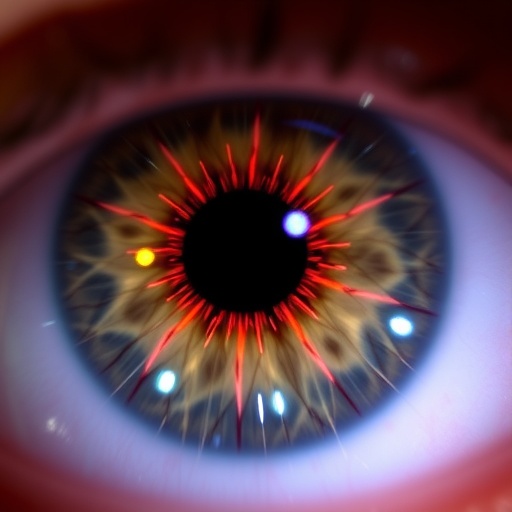A groundbreaking randomized clinical trial has delivered pivotal insights into the impact of donor diabetes status on endothelial cell health following Descemet membrane endothelial keratoplasty (DMEK). This highly specialized corneal transplant procedure, which replaces diseased endothelium with a healthy donor Descemet membrane and endothelium, relies critically on the viability of donor endothelial cells to ensure graft success. The study’s findings offer definitive evidence that the presence of diabetes in corneal donors does not adversely affect endothelial cell loss or morphometric characteristics at one year post-DMEK, challenging longstanding apprehensions within ophthalmic transplant surgery.
The clinical trial meticulously evaluated endothelial cell density and morphometric parameters—essential biomarkers of corneal graft function—to assess whether diabetes mellitus in corneal donors compromises graft survival or cellular integrity following transplantation. Endothelial cells maintain corneal transparency by regulating stromal hydration, and their attrition can precipitate graft failure. Given that diabetes induces systemic microvascular and metabolic dysregulation, concerns were rife that diabetic donor tissue might harbor subclinical endothelial damage, thus reducing graft longevity.
Contrary to these concerns, the trial’s results demonstrate no statistically significant difference in the rate of endothelial cell loss or morphometric alterations between corneas sourced from donors with diabetes and those without. Over the course of one year, cell density remained comparably robust, and morphometry—a measure of cell shape and size uniformity—was stable across both cohorts. These findings substantiate the thesis that diabetic donor corneas retain functional and structural integrity sufficient for successful endothelial keratoplasty.
This revelation holds profound clinical implications, particularly amid the burgeoning demand for donor corneal tissue worldwide. The inclusion of diabetic donor tissue could substantially expand the available pool of transplantable grafts, mitigating tissue shortages that limit timely surgical intervention. A prior reticence among surgeons to accept corneas from diabetic donors has, until now, restricted the utilization of a significant segment of the donor population, especially as diabetes prevalence escalates globally.
The robustness of the trial is underscored by its randomized design, ensuring balanced allocation and minimizing bias. State-of-the-art imaging modalities—such as specular microscopy and confocal microscopy—enabled precise quantification of endothelial parameters. These methodologies afforded high-resolution insights into endothelial cell morphology and density, lending confidence to the reported outcomes. Furthermore, clinical assessments at multiple postoperative intervals corroborated the grafts’ functional efficacy, encompassing visual acuity recovery and absence of rejection episodes.
These compelling data advocate a paradigm shift in corneal tissue acceptance criteria, encouraging transplant surgeons to reconsider the potential utility of diabetic donor corneas. The trial’s conclusion that diabetic status does not impair endothelial graft quality aligns with growing evidence questioning the predictive value of systemic disease markers on ocular tissue viability. This harmonizes with advances in tissue preservation and surgical techniques enriching graft outcomes irrespective of donor comorbidities.
Moreover, the findings invite further exploration into the biochemical and cellular resilience of corneal endothelium in diabetic milieus. Investigations into endothelial cell metabolism, oxidative stress responses, and extracellular matrix interactions in donor corneas may elucidate mechanisms underpinning their preserved function despite systemic disease. Such research could spur innovations in donor screening, storage protocols, and preoperative tissue conditioning.
Importantly, the study also emphasizes the necessity of rigorous postoperative follow-up with endothelial imaging to monitor graft health longitudinally. While one-year results are promising, extended surveillance will be indispensable to confirm the durability of these observations and detect late-onset endothelial failure if it occurs. Integration of biomarkers of endothelial cell stress or apoptosis may further refine postoperative prognosis.
In the clinical arena, adopting diabetic donor corneas for DMEK could expedite transplantation schedules, enhance access for patients with endothelial dystrophies, and alleviate healthcare system burdens. Stakeholders—including eye banks, surgeons, and policy makers—may increasingly advocate policy revisions to incorporate diabetic donor tissue, leveraging this expanding evidence base. Collaboration to disseminate these findings widely will be crucial to overcoming entrenched biases and informing evidence-based clinical guidelines.
This study represents a landmark advance in corneal transplant ophthalmology, offering reassurance to surgeons and patients alike that diabetic donor tissue does not compromise graft viability. As the global population ages and diabetes prevalence rises, such data-driven expansions of donor criteria will be essential to sustaining and improving vision-restorative interventions worldwide. The trial’s findings signal an auspicious step toward optimizing donor utilization while maintaining stringent standards of surgical excellence and patient safety.
Encompassing key aspects of ocular biology, surgical innovation, and clinical therapeutics, this research epitomizes the synergy of interdisciplinary collaboration in advancing ophthalmic care. Its dissemination at premier forums such as the Cornea and Eye Banking Forum and the American Academy of Ophthalmology’s annual meeting ensures comprehensive engagement with clinical practitioners and researchers. This publication in JAMA Ophthalmology represents a critical milestone with potential to reshape corneal transplantation practices on a global scale.
The study’s corresponding author, Dr. Jonathan H. Lass, is available for expert commentary and further inquiries via email. A commitment to transparency and data sharing will underpin subsequent analyses and secondary publications, enabling the ophthalmic community to maximize the translational impact of these findings. The embrace of diabetic donor corneas in endothelial keratoplasty heralds a future of enhanced resource utilization and preserved vision for countless patients worldwide.
Subject of Research: The impact of cornea donor diabetes status on endothelial cell loss and morphometry after Descemet membrane endothelial keratoplasty (DMEK).
Article Title: Not provided in content.
News Publication Date: Not provided in content.
Web References: Not provided in content.
References: (doi:10.1001/jamaophthalmol.2025.4261)
Image Credits: Not provided in content.
Keywords: Diabetes, Cornea, Epithelial cells, Tissue, Medical treatments, Ophthalmology, Randomization, Clinical trials




